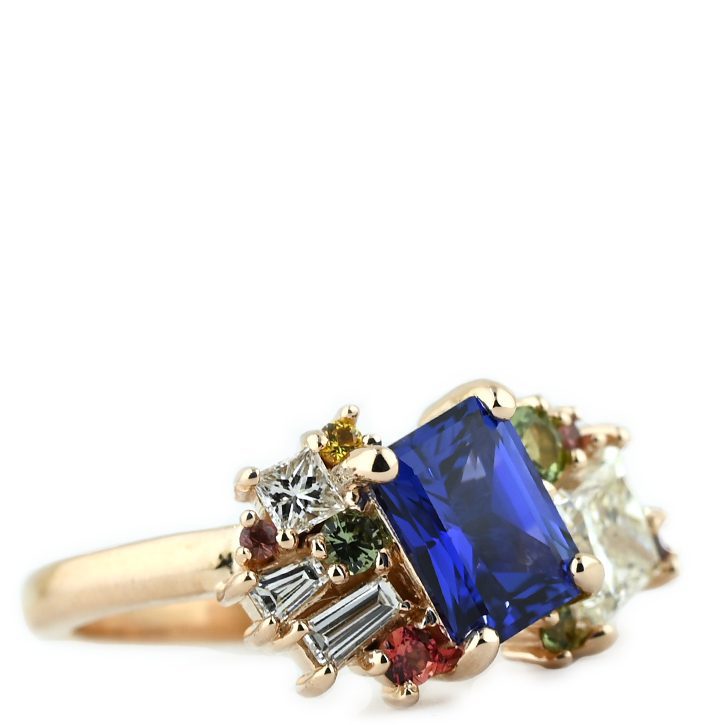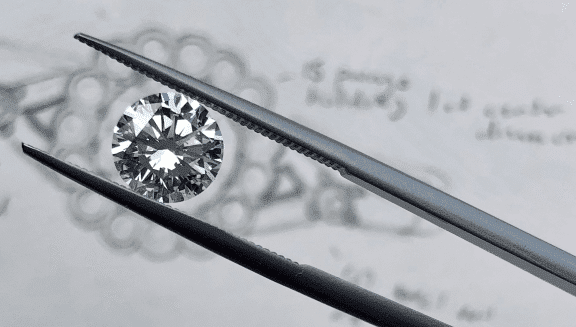Sapphire Engagement Rings: Meaning, Durability, and Types
Anyone who has seen an intensely hued sapphire knows how mesmerizing the stone’s saturated colors are. Unmistakably vivid, sapphire engagement rings have long been favored by royalty and fashion-forward brides looking for a bold and timeless alternative to diamonds. We at Abby Sparks Jewelry would like to celebrate the aristocratic sapphire and everything that makes it a classic choice for an engagement ring.
Choosing a sapphire engagement ring is a stunning way to express timeless elegance and individuality. Known for their deep, captivating blue hue, sapphires symbolize wisdom, loyalty, and strength—perfect for representing a lasting commitment. Unlike diamonds, sapphires offer a unique pop of color while still being incredibly durable, making them ideal for daily wear. Available in a range of shades, including pink, yellow, and even white, sapphires allow for more personalization and a distinctive, non-traditional look. If you’re seeking a ring that’s both beautiful and meaningful, a sapphire engagement ring is a standout choice.
Sapphire Origins

Sapphires have enjoyed a long and well-documented place in history. The word “sapphire” comes from the Greek sapheiros meaning blue and can also be roughly translated to “dear to the planet Saturn” in many languages. Sapphires were first discovered in India in the 1800’s and the majority have been mined in Sri Lanka, Madagascar, Myanmar, and Australia, though they are found all over the world. Sapphires were found in 1865 in the state of Montana by early prospectors looking for gold, leading to the nickname “The Treasure State.” Sapphires are formed from the mineral corundum and they get their color when other minerals are present. Different mineral combinations result in different colors of sapphires, with titanium contributing to the famous blue color. How slowly magma cools during formation is what lends to a sapphire’s size, and a slow cool paired with a lack of other elements and minerals is extremely rare. The combination of all of these elements are what creates the unique color, size, and inclusions present in each gemstone, meaning that no two sapphires are alike.
Types of Sapphires
The Kelsey custom sapphire engagement ring, featuring platinum and a 4.7 carat lab grown sapphire. Made exclusively by Abby Sparks Jewelry.
No matter your budget and your color preference, you have your pick when it comes to sapphire options. Though blue sapphires are by far the most well-known, sapphires are naturally occurring in every color of the rainbow depending on where and how they’re formed. There’s a wide range of sapphire types, from nearly translucent white sapphire, to dark, moody and almost black. They also come in yellow, green, pink, purple, orange, gray, brown, and all of the colors in between. Salmon-colored Padparadscha sapphires are some of the rarest and most valuable, as are vividly saturated Kashmir blues.
One color sapphires aren’t? Red. (A little known fact is that the presence of red corundum differentiates a ruby from a sapphire, but all other colors fall under the sapphire umbrella.) Looking for a more ethereal vibe than the traditional saturated hues of sapphire? Montana sapphires are typically pale and dreamy, including some color-change and bi-color sapphires that appear different colors depending on the light and angle. Like many gemstones, lab created sapphires are an earth-friendly (non-mined) and budget-friendly option that has the same chemical, physical, and optical properties of their natural counterparts.

Sapphire Engagement Ring Meaning
If you seek meaning in an engagement ring stone, the sapphire’s colorful history doesn’t disappoint. Due to their similarity with the color of the sky, sapphires have been prized since ancient times. Sapphire has had religious significance to Catholics and ancient Persians alike, and were worn in talisman in the Middle Ages to protect the wearer from evil. During this time the gemstone was also ground up and taken medicinally as a cure-all for negative thoughts, heart trouble, muscle pain, cowardice, and the ingestion of poison. In 11th century Asia, sorcerers used sapphire to promote wisdom and psychic ability.
Because of their fame, beauty and power, sapphires have long been favored by royalty, most famously the center stone in Kate Middleton’s and Princess Diana’s ring. Universal meanings for sapphire include wisdom, nobility, truth, sincerity, and faithfulness–a meaningful combination for an engagement ring. It’s this type of romantic connotation that has persevered into modern times. As an engagement ring, sapphires are a perfect representation of the loyalty present in your relationship. Their timeless but still somewhat unconventional color is a huge draw for those that want a truly unique ring.
Sapphire Engagement Ring Durability
The Julie custom sapphire engagement ring, featuring 14k yellow gold and a 6.8 carat sapphire.
As far as gemstones go, sapphires are some of the most durable options on the market. Though no other stones compare to diamonds in terms of hardness, sapphires do come pretty close. Gemstone hardness is measured by the Mohs Scale, a universally accepted ranking that ranges from super soft pearls to hardest-material-on-earth, diamonds. Whereas diamonds are a 10 out of 10, sapphires clock in at a 9. It’s important to note that the scale isn’t linear, so though they’re one point away, diamonds are many many times more durable than sapphires. With that being said, they’re your best best for a non-diamond ring (besides moissanite which is 9.5). Like all engagement rings, sapphire rings are not suitable for 24/7 wear (see 3 unexpected times when you shouldn’t wear your engagement ring) but because of the sapphire’s hardness, it’s a great stone for long term wear. If you work with a skilled jewelry designer like Abby Sparks Jewelry, we can make sure that you start off with a high quality stone and set it in an engagement ring design that will help protect the sapphire from everyday mishaps and accidents. If you’re into sapphires, make sure to check out all of our sapphire engagement rings, non-traditional engagement rings, alternative engagement rings, and gemstone engagement rings.
To summarize:
Sapphire engagement rings offer several appealing advantages…
- Unique Beauty: Sapphires, especially in their signature deep blue, provide a striking and vibrant alternative to traditional diamonds, making them perfect for those seeking something distinctive.
- Symbolism: Sapphires symbolize loyalty, wisdom, and trust—ideal qualities to represent in an engagement ring.
- Durability: With a hardness of 9 on the Mohs scale, sapphires are extremely durable and perfect for everyday wear, resisting scratches and damage.
- Color Variety: Sapphires come in a wide range of colors, including pink, yellow, green, and white, allowing for personalization and unique designs.
- Affordability: Sapphires are often more affordable than diamonds of comparable size and quality, offering a luxurious yet budget-friendly option.
- Ethical Sourcing: Sapphires can often be traced to ethically responsible sources, making them a more eco-conscious and ethical choice for an engagement ring.
These factors make sapphire rings both beautiful and practical for lasting wear!








Comments